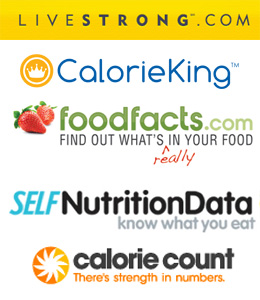 In the course of writing for this blog, I find myself looking up the calorie content and nutrition information on a variety of food products, from the exquisitely healthy to the very unhealthy. I use a number of free online tools to find this information, and it occurred to me that our readers could benefit from a quick run-down of the different sites out there and the resources they offer.
In the course of writing for this blog, I find myself looking up the calorie content and nutrition information on a variety of food products, from the exquisitely healthy to the very unhealthy. I use a number of free online tools to find this information, and it occurred to me that our readers could benefit from a quick run-down of the different sites out there and the resources they offer.
First and foremost, all of these sites will tell you a reasonable portion size for almost any given food and its corresponding calories. You can search both name-brand products and generic types of foods. They will also give you a “Nutrition Facts” panel such as you would find on a food package, that include varying degrees of detail. Many of these sites will also give you some sort of composite grade or score, which makes it easier to compare the nutritional quality of foods. A few of these sites also offer a visual tool to accompany this information.
FoodFacts is one of our newer resources, and it certainly has a lot of features to offer users. In addition to calories and nutrition facts panel, one of the big features that sets this site apart from the others is the FoodFacts Health Score. The scores range from 1 to 100, the higher the score the higher the nutritional value. The score is accompanied by the “thumbs up” that make a given food good and the “thumbs down” that many be problematic. FoodFacts is also the only site that provides users with a list of ingredients in processed foods. If you choose to make a customized account, FoodFacts will highlight in red the ingredients you wish to avoid.
CalorieCount.com
CalorieCount also offers a rating system to help users know how healthy a food is at a glance. They use a letter grade, “A,” for the very healthy and lower grades for less healthy foods. However, not all the food products in their database have a grade. If the food does have a grade, you will also be able to see the good and bad points about that food. Every food also has a pie chart that shows users the percentages of calories from carbs, fats, protein and alcohol. Creating an account with CalorieCount allows users to log their foods daily in an online food journal.
The big advantage to CalorieKing is that users can adjust the serving size, either by entering the number of servings (or fraction of a serving) or by making a selection from the drop down window. Changing the serving size will automatically readjust the Nutrition Facts panel. The site also shows users a breakdown of calories from protein, fat and carbohydrate on an interactive pie chart. Plus, CalorieKing includes the number of minutes spent doing different physical activities to burn the number of calories in that food. The site also offers a food journaling feature.
Self’s NutritionData tool offers by far the most visual aids to understanding how healthy different foods are, but is also more complicated to parse. There’s a caloric ratio pyramid, a nutritional target map and a graph labeled “Nutrient Balance” that looks like a weather radar screen. But below all of that are a number of familiar panels that give you a highly detailed breakdown of all the vitamins, minerals and other nutrients that you could ever wonder about. Each food also gets a rating out of five stars if the food is optimal for weight loss, health or weight gain.
By the way, the seemingly confusing graphics are actually quite interesting if you have the time to read them. The nutritional target map shows you how nutritious a food is vs. how much it will make you feel full. The caloric ratio pyramid shows if a food is mostly composed of carbohydrates, fats or proteins. The Nutrient Balance graph shows what nutrients that food contains and offers a “completeness” score that reveals how healthy a food is, on a scale of 0 to 100.
LiveStrong.com
I’m going to admit some personal preference here: I like LiveStrong’s nutrition info tool the least of all the sites mentioned here. A given food’s nutrition facts are interrupted by a variety of text ads, which I find distracting. The page is mostly designed for those using LiveStrong’s food journaling feature, and the info is otherwise very basic: calories, a few nutrients, a small and almost buried pie chart of the calories from fat, carbs and protein. Also looking like the ad directly above it in the left column are several physical activities that you could do to burn off the calories in that food. The page also offers foods “frequently eaten with” the food you are looking at. LiveStrong provides users with many great health and fitness tools, but personally, I don’t think their nutrition data is one of them.
